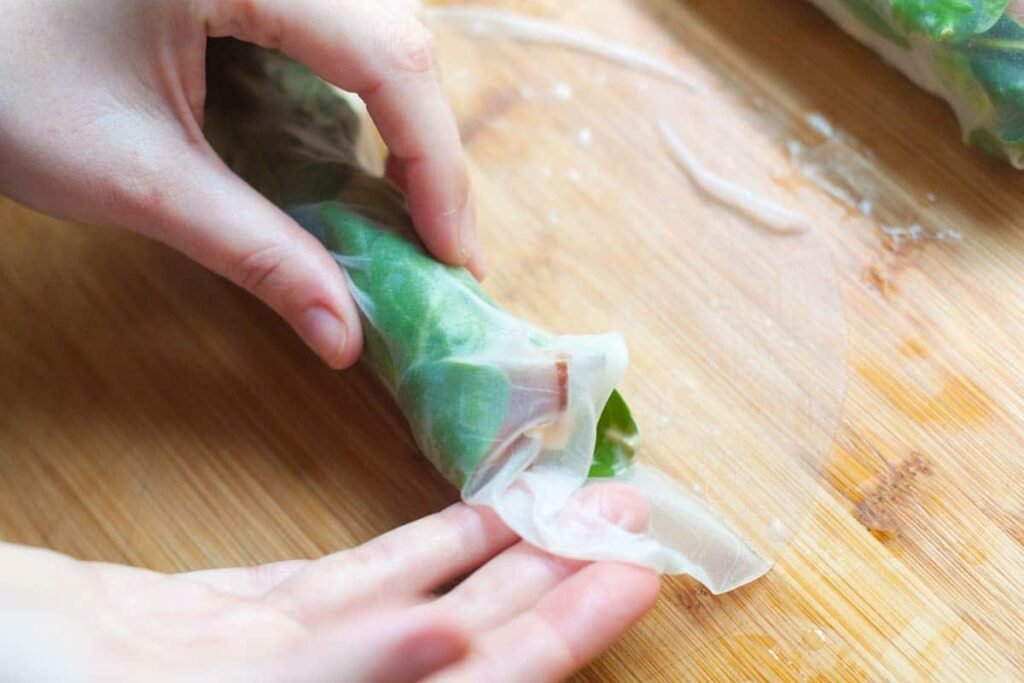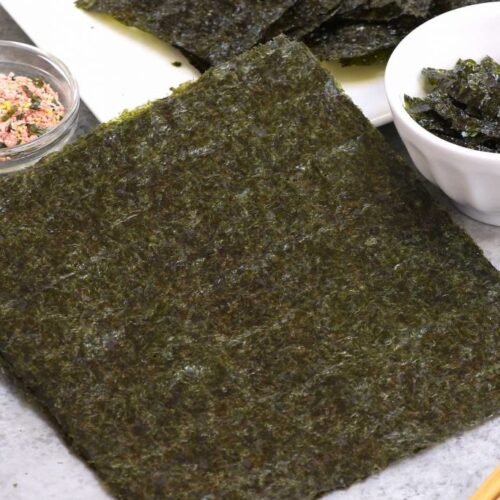Are you a sushi lover who is looking for an alternative to nori?
Nori is the seaweed used to wrap sushi rolls and make them look beautiful.
It has a distinctive flavor that can be hard to replicate, but there are some great substitutes out there.
Whether you’re looking for something with a similar texture or flavor, I have compiled 12 of the best substitutes for nori that will satisfy your craving without breaking the bank.
From kale and cabbage leaves to dulse flakes and hijiki powder, these alternatives will help you create delicious dishes without compromising on taste.
What is Nori?

Nori is a type of edible seaweed that is most commonly used in Japanese cuisine.
It has a mild, slightly sweet flavor and an umami-rich aroma.
Nori is usually sold as dried sheets or flakes, which are then rehydrated before use.
The sheets can be cut into strips and used to wrap sushi rolls, while the flakes can be sprinkled over dishes for added flavor and texture.
Nori grows naturally on rocks near the shoreline in shallow waters around Japan, Korea, China, and other parts of East Asia.
It is harvested by hand during low tide when it’s exposed to air.
After harvesting, the nori is washed with fresh water and spread out on bamboo mats to dry in the sun or indoors using special drying machines.
Once dry, it’s pressed into thin sheets or ground into flakes before being packaged for sale.
The 12 Best Substitutes For Nori
Nori is a delicious seaweed used in many Asian dishes, but if you can’t find it then here are 12 great alternatives.
From chlorella and kombu to dulse flakes and wakame, these substitutes will give you the same umami flavor without having to search for nori!
1. Rice Paper

Rice paper is a thin, edible sheet made from rice flour and water.
It is used in many Asian cuisines, particularly Vietnamese and Chinese cooking.
Rice paper can be eaten raw or cooked, and it has a mild flavor that pairs well with other ingredients.
Rice paper can be used to wrap spring rolls, make dumplings, or as an alternative to nori for sushi rolls.
It’s also great for making wraps filled with vegetables and herbs like lettuce, cucumber, mint leaves, cilantro and more!
Pro Tip: To soften the rice paper before using it in recipes such as spring rolls or dumplings, simply dip each sheet into warm water for about 10-15 seconds until it becomes pliable.
2. Soy Wraps
Soy wraps are a great alternative to nori, the seaweed wrap used in sushi.
Soy wraps are made from soybeans and other natural ingredients like rice flour, tapioca starch, and salt.
They have a mild flavor that pairs well with both savory and sweet fillings.
Unlike nori, which is usually dried before use, soy wraps must be cooked before eating.
To prepare them, simply heat each side of the wrap on a dry skillet for about 30 seconds until it’s lightly browned and pliable.
Then you can fill it with your favorite ingredients!
Soy wraps are also much healthier than nori as they contain no saturated fat or cholesterol and are high in protein and dietary fiber.
Plus they’re gluten-free so they’re perfect for those with food allergies or sensitivities!
3. Tofu Skin
https://www.pinterest.com/pin/346425396343893855/Tofu skin, also known as yuba or bean curd skin, is a thin layer of protein that forms on the surface of boiled soy milk.
It’s made from the same ingredients as tofu—soybeans and water—but it has a different texture and flavor.
Tofu skin has a mild nutty flavor with hints of sweetness.
It can be used in place of nori for sushi rolls or added to soups and stir-fries for extra protein and texture.
It can also be deep-fried until crispy and served as an appetizer or snack.
Pro Tip: To get the most out of your tofu skin, try marinating it in soy sauce, sesame oil, garlic, ginger, and other seasonings before cooking! This will give it more flavor and make it even more delicious!
4. Lettuce or Shiso

Nori is a type of edible seaweed, most commonly used in Japanese cuisine.
It has a mild flavor and is often used to wrap sushi rolls or as a garnish for soups and salads.
If you’re out of nori, lettuce or shiso are great alternatives!
Lettuce can be used as a wrapper for sushi rolls, while shiso leaves have an herbal flavor that pairs well with fish dishes.
Both lettuce and shiso are also rich in vitamins A and C, making them healthy additions to any meal.
Shiso leaves can be eaten raw or cooked, but they should always be washed thoroughly before use.
They can also be dried and ground into powder form to make a flavorful seasoning for rice dishes or stir-fries.
5. Thinly Sliced Cured Meats
https://www.pinterest.com/pin/133630313939728891/Thinly sliced cured meats, such as prosciutto, are a great alternative to nori.
They can be used in place of nori in sushi rolls or wraps and provide a savory flavor and texture.
Cured meats are usually made from pork, beef, or poultry that has been salted and dried for preservation.
The salt helps to draw out moisture from the meat while also adding flavor.
Cured meats are high in protein and have a long shelf life when stored properly.
They can be enjoyed on their own as an appetizer or snack, added to sandwiches or salads, or used as an ingredient in recipes like pasta dishes and casseroles.
Thinly sliced cured meats make a great substitute for nori because they add flavor without overpowering the other ingredients in the dish.
6. Paper-thin Omelet
https://www.pinterest.com/pin/139682025934059160/Paper-thin omelet, also known as tamagoyaki, is a Japanese rolled egg dish.
It is made by rolling together thin layers of cooked egg in a rectangular or square pan.
The resulting omelet has a unique texture and flavor that can be enjoyed on its own or used as an ingredient in other dishes.
Paper-thin omelets are usually served with soy sauce and wasabi for dipping, but they can also be used to wrap sushi rolls or fill sandwiches.
They are light and fluffy yet still have enough structure to hold their shape when cut into slices.
Pro Tip: To make the perfect paper-thin omelet, use fresh eggs and cook them over low heat until just set before rolling them up into thin layers. This will ensure that your omelet has the right texture and flavor!
7. Dried Bonito Shavings
https://www.pinterest.com/pin/310326230586110428/Dried bonito shavings, also known as katsuobushi, are thin flakes of dried and smoked skipjack tuna.
They are a key ingredient in Japanese cuisine and have a strong umami flavor.
The shavings can be used to make dashi (a type of broth) or sprinkled on top of dishes for added flavor.
Dried bonito shavings are an excellent substitute for nori, the seaweed commonly used to wrap sushi rolls.
The smoky flavor of the shavings adds depth to any dish and pairs well with other ingredients like soy sauce, mirin, sake, and miso paste.
It’s also great for adding texture to salads or soups!
8. Tororo Kombu
https://www.pinterest.com/pin/479492691562790193/Tororo Kombu is a type of edible seaweed that is commonly used in Japanese cuisine.
It has a mild, slightly sweet flavor and can be eaten raw or cooked.
The texture of Tororo Kombu is similar to nori, but it has a more delicate taste and aroma.
Tororo Kombu can be used as an ingredient in sushi rolls, soups, salads, and other dishes.
It’s also great for making dashi (Japanese soup stock) or as a topping for rice dishes.
Its mild flavor makes it perfect for adding depth to any dish without overpowering the other flavors.
9. Smoked Salmon

Smoked salmon is a type of cured fish that has been smoked over an open fire or in a smokehouse.
It is usually made from Atlantic, Pacific, or Chinook salmon and can be found in many grocery stores and specialty shops.
Smoked salmon has a unique flavor profile that combines the smokiness of the wood with the saltiness of the curing process.
The texture is firm yet flaky, making it perfect for adding to salads, sandwiches, omelets, and other dishes.
Pro Tip: To get the most out of your smoked salmon experience, try pairing it with cream cheese or capers for added flavor!
10. Pickled Leaves

Pickled leaves are a type of pickle made from various types of leafy vegetables.
They are popular in many parts of the world, including India, China, and Southeast Asia.
Pickled leaves can be eaten as a snack or used as an ingredient in dishes such as salads and stir-fries.
Pickled leaves have a salty, sour flavor that is similar to nori but with more complexity.
The pickling process also helps to preserve the nutrients in the leaves, making them a healthy alternative to nori.
Pickled leaves can be found at most Asian grocery stores or online retailers.
11. Thin Deep-Fried Tofu
Thin deep-fried tofu is a popular snack in Japan.
It is made by slicing thin pieces of firm tofu, coating them with potato starch or cornstarch, and then deep-frying them until they are golden brown and crispy.
The resulting texture is similar to that of nori, but with a slightly softer bite.
The flavor of the fried tofu can be enhanced by adding various seasonings such as soy sauce, mirin, sugar, garlic powder, onion powder or sesame oil.
Thin deep-fried tofu can be served as an appetizer or side dish for any meal. It also makes a great topping for salads and soups!
12. Cucumber Wraps
Cucumber wraps are a great alternative to nori, the seaweed wrap commonly used in sushi.
Cucumber wraps are easy to make and provide a light, refreshing flavor.
To make cucumber wraps, simply cut thin slices of cucumber and use them as wrappers for your favorite fillings.
You can stuff them with cooked rice, vegetables, or even fish or meat!
The cucumbers will add a subtle crunch and freshness that pairs nicely with the other ingredients.
Pro Tip: If you want to give your cucumber wraps an extra kick of flavor, try adding some sesame oil or soy sauce before wrapping them up!
Can you make sushi without nori?
Yes, you can make sushi without nori. Rice paper wrappers are a great alternative to nori sheets, as they are easy to work with and can often be found at most grocery stores.
This makes them an accessible, budget-friendly substitute.
When making maki sushi without nori, the rice paper wrappers will provide the necessary structure and hold the sushi filling together. In comparison to nori, they are more pliable and can help give the sushi rolls a unique look.
Additionally, they are also thinner, making them easier to roll and shape.
Conclusion
In conclusion, Nori is a common ingredient in many Asian dishes, but it can be hard to come by in some areas.
Fortunately, there are many great substitutes for Nori that can provide the same flavor and texture profile.
The best substitutes for Nori are rice paper, soy wraps, tofu skin, lettuce or shiso, thinly sliced cured meats, paper-thin omelet, dried bonito shavings, lettuce, tororo kombu, smoked salmon, pickled leaves, shiso (Japanese basil), thin deep-fried tofu, soy wraps (mamenori), and cucumber wraps.
All of these can be used to create delicious dishes that are packed with flavor and texture.
So, the next time you’re in a pinch and don’t have Nori, reach for one of these substitutes and give it a try.

The 12 Best Substitutes For Nori
Ingredients
- Rice Paper
- Soy Wraps
- Tofu Skin
- Lettuce or Shiso
- Thinly Sliced Cured Meats
- Paper-thin Omelet
- Dried Bonito Shavings
- Tororo Kombu
- Smoked Salmon
- Pickled Leaves
- Thin Deep-Fried Tofu
- Cucumber Wraps
Instructions
- Pick your favorite substitute from the list above.
- Follow cooking directions for your selected substitute with the proper ratio of ingredients.
Hi, I'm Benjamin. I love cooking, long walks, and my girlfriend! Here you’ll find simple and delicious recipes that you can make in 30 minutes or less.

